
The following are 30 strength exercises for endurance athletes: five each for all endurance athletes, cross-country skiers, cyclists, rowers, runners, swimmers, and triathletes. Note that the five strength exercises for triathletes draw one from the list for cyclists, two from the list for runners, and two from the list for swimmers.
It is wise to start with an adaptation phase if these exercises are new or you are not currently strength training. Spend two to three weeks practicing the movements with very light loads (in the case of non-body-weight exercises) to get the coordination down. Then you can move on to heavier loads. As you might recall from Chapter 9, you want to work up to the heavier loads because they complement your endurance training, building power and a leaner body.
Strengthens the lateral core stabilizers to improve the stability of the spine, pelvis, and hips during athletic activities
Lie on your side with your ankles together and your torso propped up by your upper arm. Lift your hips upward until your body forms a diagonal plank from ankles to neck. Hold this position for 20 to 30 seconds, making sure you don’t allow your hips to sag toward the floor. (Watch yourself in a mirror to make sure you’re not sagging.) Switch to the other side, and repeat the exercise.

Strengthens the gluteals and hamstrings
Lie face up on the floor with your knees bent 90 degrees and your feet flat on the floor. Contract your gluteals and lift your hips until your body forms a straight line from neck to knees. Hold this position for 5 seconds, keeping your buttocks squeezed together; then return to the starting position. Complete 10 repetitions.

Builds the endurance of the spinal stabilizers
Lie on the floor on your stomach, with your upper body supported on your forearms and your toes pressed into the ground. Maintain a 90-degree bend in your elbows, and make sure they are placed directly underneath the shoulders. Tighten your entire core area, and lift your hips up and in line with your legs and torso. Hold this position for up to 30 seconds without allowing your hips to sag. If you can hold the prone plank position longer than 30 seconds, make it more challenging by doing it with your left foot elevated a few inches above the floor for 15 seconds, then your right foot elevated for 15 seconds.

Strengthens the trunk rotational stabilizers to improve the stability of the spine, pelvis, and hips during athletic activities
Stand with your left side facing a cable pulley station. Attach a D-handle at shoulder height, and begin with your trunk rotated toward the weight stack and your arms fully extended with the handle grasped in both hands. Keeping your arms extended and your hands in line with the center of your chest, rotate your trunk to the right. Keep your abdominal muscles tightened, and avoid hunching your shoulders as you do so. Stop when your hands are at about the “1 or 2 o’clock” position (with the “12 o’clock” position being hands directly out in front of you); then return to the starting position. Repeat 10 to 12 times; then reverse your position, and perform a set twisting in the opposite direction.
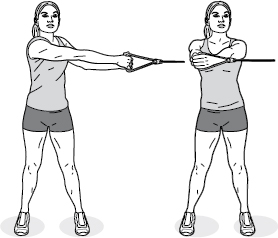
Strengthens the lower back muscles to improve the stability of the spine, pelvis, and hips during athletic activities
Lie face down on a Swiss ball with your upper thighs, pelvic area, and stomach supported by the ball and only your toes touching the floor and your arms extended directly forward, Superman-style. Contract your lower back muscles, and lift your torso upward, keeping your arms in line with your spine. Extend your spine as much as possible; then return to the starting position. Repeat 12 to 15 times.

Strengthens the hamstrings, gluteals, and lower back for more powerful leg action
Stand with your feet close together, knees bent very slightly, with a dumbbell next to each foot. Set your core, and then bend forward at the waist and grab the dumbbells. With arms at your side and knees locked in the slightly bent position, return to a standing position. Pause briefly, and then bend forward to do another repetition. Complete 10 to 12 repetitions in total.

Strengthens the gluteals, hamstrings, and quadriceps and corrects muscular imbalance in the thigh muscles
Stand facing an exercise bench or a step (12 to 18 inches high) while holding a dumbbell in each hand at your sides. Step up onto the bench with your right foot, and then push off your right heel as you raise your left leg so that you’re standing on the bench. Step back down with your left leg. Continue stepping up and down, pushing with your right leg and carrying your left leg along for the ride, until you complete a full set of 10 repetitions; then switch legs, and repeat with your left leg doing the work.

Strengthens the rotator cuffs, scapular stabilizers, and abdominals and corrects imbalances in the shoulder girdle and trunk
Kneel on the floor facing the ball, lean forward slightly, and place your forearms on top of the ball. Pull your belly button toward your spine. Slowly roll the ball forward by extending your forearms out in front of you and allowing your body to tilt toward the floor. Concentrate on maintaining perfect alignment of your spine. Stop just before you’re forced to arch your back. Hold this position for 3 seconds, and then return to the starting position, exhaling as you do so. Do up to 12 repetitions.

Strengthens upper-back muscles as well as the elbow flexors and grip and helps to prevent shoulder problems
Set up a pulley with the rope attachment just above forehead level. Stand facing the pulley in a split stance, and grasp the two ends of the rope with your palms facing each other. Extend your arms straight out in front of you with the hands slightly above shoulder height. Pull the center of the rope attachment toward your forehead by retracting your shoulder blades and forcing your elbows out (not down). As the rope approaches your face, your shoulder blades should be pulled back and down, with the chest high and your hands coming even with your ears. You should feel the resistance in your midback and in the back of your shoulders. Do 10 to 12 repetitions.

Strengthens the quadriceps and hips for more stable and efficient leg action
Stand with your right side facing an exercise bench or step while holding a dumbbell in your left hand with your left arm relaxed at your side. Draw your belly button gently inward toward your spine to brace your core. Place your right foot on the step, and then straighten your right leg completely so that you’re now standing on the step with your left leg unsupported. Be sure not to push off the floor with your left ankle—make your right leg do all the work of lifting your body to the height of the bench. Now step back down. After completing a full set of 10 repetitions, reverse your position, and repeat with your left leg doing the work.
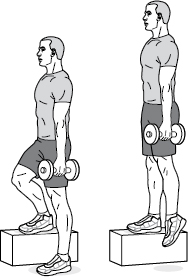
Strengthens the quadriceps for a more powerful pedal stroke
Stand on a 4- to 6-inch step with your arms resting at your sides and a dumbbell in each hand. Take a big step backward with one leg, and bend both knees until the back foot hits the ground and the back knee almost grazes the floor. Then thrust powerfully upward and forward off the back foot to return to the starting position. Be sure to maintain an upright torso posture throughout the movement. Complete 10 repetitions with one leg, rest, and then work the opposite leg.

Strengthens the gluteals, hamstrings, and quads for a more powerful pedal stroke
Stand with your feet slightly more than shoulder-width apart. Begin with a weighted barbell resting against your upper back and your hands grasping the bar on either side halfway between your neck and the weight plates. Draw your navel toward your spine; then lower your buttocks toward the floor as though sitting in a chair. Stop when your thighs are almost parallel to the floor; then return to the starting position. Complete 10 repetitions.
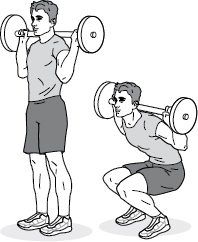
Strengthens the lower back to reduce the risk of low-back pain resulting from cycling
Stand tall with your feet placed slightly farther than shoulder-width apart and your arms extended straight upward, palms facing forward, with a light dumbbell (optional) in each hand. Tighten your core. Bend forward at the waist (avoid rounding your back), and reach the dumbbells toward your toes, going as far as you can without bending at the knees. Try to keep your arms more or less in line with your torso all the way down. Now return slowly to the upright position, standing tall with arms overhead. Again, maintain a neutral spine. Repeat to the point of moderate fatigue or up to 20 repetitions.
Note: Do not perform this exercise if you have a history of low-back injury, or if you have any reason to believe you might be prone to low-back pain.

Strengthens the upper back and rear shoulders to correct the forward rounding of the shoulders that often develops in cyclists
Stand in a wide stance with your knees slightly bent and your left side facing a cable pulley station with a D-handle connected to the low attachment point. Grasp the handle in your right hand using an underhand grip. Bend forward 45 degrees from the hips. Begin with your right arm extended and the handle positioned directly underneath your breastbone. Tighten your core. Now pull the handle outward and upward until your right arm is fully extended and parallel to the floor. Pause briefly and return to the starting position. Complete 10 to 12 repetitions; then reverse your position, and work the left shoulder.

Strengthens the gluteals and hamstrings to generate more power during the pull phase of a pedal stroke
Lie face down on the floor, and have a partner press your lower legs down into the floor just so that your body can only move from the knees up. With your arms in standard push-up position, give a slight push off the floor while you contract your hamstrings and lift your body (from knees to head) upward until you are in a fully upright kneeling position. Try to keep your torso erect throughout the movement, and use the hamstrings to pull your body up and the gluteals to finish the movement by tilting the pelvis back (just think of popping the hips forward to get your body upright). Lower yourself back to the floor. Do 8 to 10 repetitions.

Targets the posterior chain (hamstrings, gluteals, low back) for efficient transfer of force from legs to upper body in rowing
Stand facing away from a cable column with the rope attachment set in the bottom position. Set your feet slightly farther than shoulder-width apart so that you have room to reach between your legs with both arms fully extended, and grasp the two ends of the rope with your palms facing each other. Bend your knees slightly, and bend forward slightly at the hips to counterbalance the pull of the rope, keeping your weight on your heels. To initiate the movement, let the weight pull your hips back as if someone had a rope around your waist pulling you backward. Now begin tilting your torso forward from the hips (not the waist), and allow the weight to pull your extended arms between your legs. Avoid rounding your back. The lowering phase ends when the torso is just short of parallel with the floor, at which point you’ll push through the heels and use your posterior chain to pull the rope forward between your legs and straighten your body back to the starting position. Push your hips forward, and squeeze your gluteals to lock out. Stand upright; don’t lean back! Do 8 to 10 repetitions.

Strengthens the gluteals, hamstrings, quadriceps, core, and upper back for more powerful leg action
Stand with your feet slightly wider than shoulder-width apart, toes turned out slightly. Grab a rolled-up towel with an overhand grip, hands shoulder-width apart, and raise it overhead so that your shoulders are roughly in line with your heels. Squat down as far as you can without feeling discomfort in your knees or hamstrings. Return to standing to complete one full rep. Do 10 to 15 repetitions.

Strengthens the front shoulder muscles to prevent shoulder-muscle strength imbalances
Stand facing away from a door gym or cable pulley station. Connect a handle to the low attachment point, and grasp it in your right hand with your right arm relaxed at your side, palm facing the door or cable pulley station. Set your core. Contract the muscles on the front of your shoulder, and lift the handle forward and upward, going just past the point where your arm is parallel to the floor. Pause briefly and return to the starting position. After completing a full set of 10 to 12 repetitions, work the left shoulder.
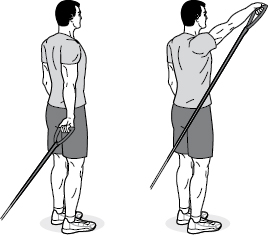
Strengthens the lower trapezius for healthy shoulders
Stand facing a cable column or pull-down machine with a straight-bar attachment. Grasp the bar with a pronated (palms-down) grip and your arms extended straight in front of you with the bar at shoulder height. Keeping your torso upright and initiating the movement with your shoulder blades and upper arms, pull the bar down until it touches your upper thighs while keeping the wrists and elbows straight. When this exercise is performed correctly, you’ll feel it in your midback, right at the base of your shoulder blades. Complete 8 to 10 repetitions.

Strengthens the deep abdominal and oblique muscles
Lie face up with your arms resting at your sides and your palms flat on the floor. Extend your legs directly toward the ceiling, touch your feet together, and point your toes. Set your core. Keeping your big toes side by side, tip your legs 12 to 18 inches to the right by twisting at the hip so that your right gluteal comes off the floor. Fight the pull of gravity by maintaining stability with your abdominals and obliques. Pause for a moment, and then return slowly to the starting position, again using your core muscles to control the movement. Repeat on the left side, and continue alternating from right to left until you have completed a full set of 8–10 repetitions in each direction.

Increases stride power by simulating the stride action with exaggerated upward thrust
Start in a split stance with your right foot flat on the ground and your left leg slightly bent, with only the left forefoot touching the ground a half step behind the right. Lower yourself down into a deep squat, and then leap upward as high as possible. In midair, reverse the position of your legs. When you land, sink down immediately into another squat and then leap again. Use your arms to maintain balance and to generate extra upward thrust with each leap. Complete 10 to 20 jumps in each stance.

Strengthens the hip abductors to increase the stability of the hips and pelvis during running
Loop a half-inch or one-inch exercise band under both feet, and stand on top of it. Your feet should be roughly 12 inches apart at the start. Cross the ends of the band to form an X, and grasp one end in each hand. Pull your chest up and shoulders back, and keep tension on the band throughout. Start walking sideways with small lateral steps. The leg that’s on the side of the direction you’re moving will have to overcome the band’s tension to take each step. Make sure that you keep the hips and shoulders level, and don’t deviate forward or backward as you step to the side. When this exercise is performed correctly, you’ll feel the movement in your gluteals. Complete 10 steps in one direction, then 10 more while moving in the opposite direction.

Strengthens the gluteals, hips, hamstrings, quadriceps, low back, and upper back
Stand with your left foot directly beneath your left hip and your right foot half a step behind the right hip with only the toe touching the floor. Put all your weight on your left foot; use the right for balance only. Begin with dumbbells positioned on the floor directly underneath your hands as your arms hang at your sides. Bend down and grab the dumbbells. Press your left foot into the floor and stand fully upright. Concentrate on extending your left knee and hip first and then lifting your torso. Keep your weight fully on your left foot throughout this movement. Pause briefly in a standing position and then lower the dumbbells back to the floor. Complete a full set of 8 to 10, then reverse your position and do another set.

Strengthens the vastus medialis to improve the stability of the knee during running
Stand on an exercise step that’s 8 to 12 inches high. Pick up your left foot, and slowly reach it toward the floor in front of the step by bending your right knee. Allow your left heel to touch the floor, but don’t put any weight on it. Return to the starting position. Complete 8 to 12 repetitions; then switch legs.
Note: The vastus medialis is the quadriceps muscle terminating in a small bulge just above the medial side of the kneecap.

Enhances the ability to resist medial tilting of the body (a cause of joint instability and overuse injuries) during the stance phase
Stand with your arms hanging at your sides and a dumbbell in one hand. Push your hips back, bend the knees, and reach the dumbbell down as close to the floor as you can without rounding your lower back. Now stand up again. Don’t allow your torso to tilt to either side while performing this movement. Complete 10 repetitions, rest for 30 seconds, and then repeat the exercise while holding the dumbbell in the opposite hand.

Creates a more powerful freestyle pull by simulating the pull action under load, strengthening the upper and midback muscles
Stand with your left side facing a cable pulley station with a D-handle attached at shoulder-to-head height. Bend your knees, and place your feet slightly more than shoulder-width apart. Use both hands to grab the handle. Your arms should be almost fully extended with your trunk twisted to the left. Now pull the handle from this position across your body and toward the floor, stopping when your hands are outside your right ankle. This is a compound movement that involves twisting your torso to the right, shifting your weight from your left foot to your right foot, bending toward the floor, and using your shoulders to pull the handle across your body. Concentrate on initiating the movement with your trunk muscles. At the bottom of the movement, pause briefly, and then smoothly return to the starting position. Complete 10 repetitions. Reverse your position, and repeat the exercise.

Strengthens the muscles responsible for body rotation during freestyle swimming for a more efficient stroke
Connect a D-handle to a cable pulley station at ankle height. Stand in a wide stance with your left side facing the cable pulley station and most of your weight on the left foot. Grasp the handle in both hands, beginning with the handle just outside your lower left shin. Using both arms, pull the cable upward and across your body, keeping your arms straight and finishing with your hands above your right shoulder. Avoid rounding your back. Return smoothly to the starting position. Complete 10 repetitions. Reverse your position, and repeat the exercise.

Strengthens the chest, triceps, and shoulder stabilizers for greater shoulder stability and lower risk of “swimmer’s shoulder”
Begin by doing a standard push-up. At the top of the movement, when your arms are completely straight, twist your body to the right and reach straight toward the ceiling with your right arm. Follow the movement of your hand with your eyes. Pause for 1 second, and then put that hand back down and twist left, reaching up with your left hand. One push-up with reaches to both sides counts as 1 repetition. Do 10 to 15 repetitions. If you can’t do at least 10 regular push-ups, do half push-ups (where you lower your chest only halfway to the floor).

Strengthens the rotator cuff muscles and reduces risk of injury
Stand with your left side facing a cable pulley station. Grasp the D-handle in your right hand, and begin with your right arm bent 90 degrees so that your forearm is pointing toward the cable pulley station across your belly. Now rotate your shoulder externally, and pull the handle across your body, keeping your elbow and upper arm pressed against your right side. Return to the starting position. Complete 10 repetitions; then repeat with your left arm.

Attenuates muscle imbalances created by swimming by essentially reversing the freestyle arm-pull action
Assume a wide stance with a single dumbbell placed on the floor between your feet. Bend your knees, tilt forward from the hips, and grasp the dumbbell with your right hand using an overhand grip (knuckles facing forward). Begin with your right arm fully extended. The objective of this exercise is to lift the dumbbell in a straight line from the floor to a point directly overhead. To do this, begin by contracting your gluteals, hamstrings, and lower back so that the dumbbell rises to thigh height as you assume an upright standing position. From this point, keep the dumbbell moving in a straight line close to your body by bending your elbow and pulling from the shoulder. As the dumbbell approaches head level, rotate and extend your arm until it is pointing toward the ceiling. Pause briefly, and then reverse the movement, allowing the dumbbell to come to rest again on the floor briefly before you initiate the next lift. Complete 10 to 12 repetitions; then switch to the right arm.

Strengthens the quadriceps for a more powerful pedal stroke
Stand on a 4- to 6-inch step with your arms resting at your sides and a dumbbell in each hand. Take a big step backward with one leg, and bend both knees until the back foot hits the ground and the back knee almost grazes the floor. Then thrust powerfully upward and forward off the back foot to return to the starting position. Be sure to maintain an upright torso posture throughout the movement. Complete 10 repetitions with one leg, rest, and then work the opposite leg.

Trains the hip abductors and external rotators to maintain hip stability during a single-leg movement similar to running
Stand on your right foot, and bend the left leg slightly to elevate the left foot a few inches above the floor. Lower your buttocks slowly toward the floor, keeping most of your weight on the heel of your support foot. Reach the left leg either behind your body (easier) or in front of your body (harder) to keep it out of the way and to help maintain balance. Squat as low as you can go without your buttocks swinging outward (a sign that the targeted muscles have become overwhelmed and that other muscles have been activated to take up the slack). Return to the starting position. Do 8 to 10 squats on each foot.
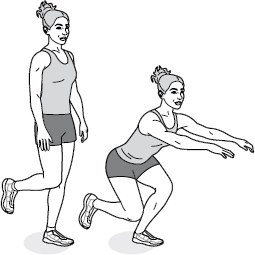
Enhances the ability to resist medial tilting of the body (a major cause of joint instability and overuse injuries) during the stance phase of running
Stand with your arms hanging at your sides and a dumbbell in one hand. Push your hips back, bend the knees, and reach the dumbbell down as close to the floor as you can without rounding your lower back. Now stand up again. Don’t allow your torso to tilt to either side while performing this movement. Complete 10 repetitions, rest for 30 seconds, and then repeat the exercise while holding the dumbbell in the opposite hand.

Strengthens the chest, triceps, and shoulder stabilizers for greater shoulder stability and reduced risk of “swimmer’s shoulder”
Begin by doing a standard push-up. At the top of the movement, when your arms are completely straight, twist your body to the right and reach straight toward the ceiling with your right arm. Follow the movement of your hand with your eyes. Pause for 1 second, and then put that hand back down and twist left, reaching up with your left hand. One push-up with reaches to both sides counts as 1 repetition. Do 10 to 15 repetitions. If you can’t do at least 10 regular push-ups, do half push-ups (where you lower your chest only halfway to the floor).
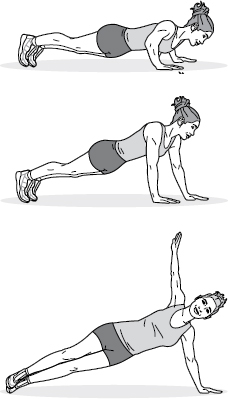
Attenuates muscle imbalances created by swimming by essentially reversing the freestyle arm-pull action
Assume a wide stance with a single dumbbell placed on the floor between your feet. Bend your knees, tilt forward from the hips, and grasp the dumbbell with your right hand using an overhand grip (knuckles facing forward). Begin with your right arm fully extended. The objective of this exercise is to lift the dumbbell in a straight line from the floor to a point directly overhead. To do this, begin by contracting your gluteals, hamstrings, and lower back so that the dumbbell rises to thigh height as you assume an upright standing position. From this point, keep the dumbbell moving in a straight line close to your body by bending your elbow and pulling from the shoulder. As the dumbbell approaches head level, rotate and extend your arm until it is pointing toward the ceiling. Pause briefly, and then reverse the movement, allowing the dumbbell to come to rest again on the floor briefly before you initiate the next lift. Complete 10 to 12 repetitions; then switch to the right arm.
